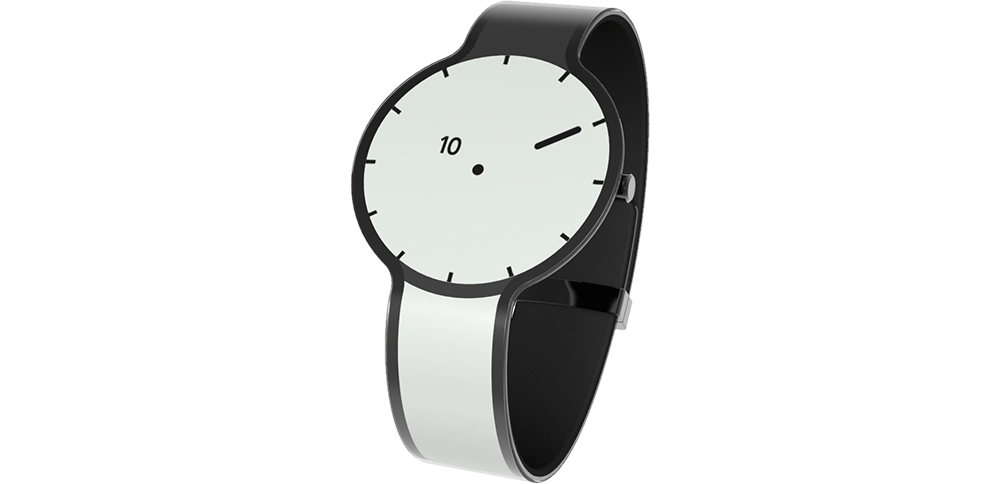Almost every tech hardware maker is basically racing smart watches out the door, but Sony is looking at how it can re-invent the basic timekeeping device itself with a new special project that was only just now revealed to be associated with the Japanese electronics giant, despite popping up on a crowdfunding site months ago. The so-called FES Watch, which uses e-paper for both the face and a wraparound band, initially kept the Sony name out of the mix to see how well it would fare in the public forum without the power of branding.
FES Watch was instead billed as the product of a company called Fashion Entertainments, but that group is actually a team of Sony employees looking at how e-paper can be used to manufacture fashion goods. The WSJ reports that it wants to make e-paper thought of as a fabric in the fashion realm, good for making things like watches, bow ties, hat accessories or any other number of worn items. The Fashion Entertainments unit is led by Hiroki Totoki, the new head of Sony’s smartphone efforts, and is part of a program of internal entrepreneurship conceived by Sony CEO Kazuo Hirai.
The FES Watch project has already raised well over $17,000 on the crowdfunding site, meaning it passed tis goal and should go to production. The decision to hide Sony’s involvement meant Fashion Entertainments could get a better sense for how the idea would fare, without any influencing effects from being associated with Sony’s brand name. Often, startups say they go to crowdfunding sites not necessarily to raise money, but to test market viability and gather feedback before a product launch, or to help them raise traditional VC cash, so while Sony’s move is not unprecedented, it may be the largest company to have employed this kind of tactic.

Turning e-paper into a fabric has a number of potential benefits – including the ability to change pattern and design of things you’re wearing in an instant, including coloured options using newer color e-ink technology. The material’s extremely low power draw means it should be able to last a long time without charging, and items made using it could easily be made to change their appearance based on movement and basic behavior, using simple motion sensors. Smart functions (i.e., notifications and communication with smartphones) might also be possible, but the spirit of the project is to keep things simple so that e-paper gets perceived as fabric or building block, and less as tech.
Pre-order customers will get their devices after next May, but there’s no word yet on general availability for the FES Watch. It’s definitely causing a stir, though, so hopefully Sony makes this more broadly available.
FES Watch was instead billed as the product of a company called Fashion Entertainments, but that group is actually a team of Sony employees looking at how e-paper can be used to manufacture fashion goods. The WSJ reports that it wants to make e-paper thought of as a fabric in the fashion realm, good for making things like watches, bow ties, hat accessories or any other number of worn items. The Fashion Entertainments unit is led by Hiroki Totoki, the new head of Sony’s smartphone efforts, and is part of a program of internal entrepreneurship conceived by Sony CEO Kazuo Hirai.
The FES Watch project has already raised well over $17,000 on the crowdfunding site, meaning it passed tis goal and should go to production. The decision to hide Sony’s involvement meant Fashion Entertainments could get a better sense for how the idea would fare, without any influencing effects from being associated with Sony’s brand name. Often, startups say they go to crowdfunding sites not necessarily to raise money, but to test market viability and gather feedback before a product launch, or to help them raise traditional VC cash, so while Sony’s move is not unprecedented, it may be the largest company to have employed this kind of tactic.

Turning e-paper into a fabric has a number of potential benefits – including the ability to change pattern and design of things you’re wearing in an instant, including coloured options using newer color e-ink technology. The material’s extremely low power draw means it should be able to last a long time without charging, and items made using it could easily be made to change their appearance based on movement and basic behavior, using simple motion sensors. Smart functions (i.e., notifications and communication with smartphones) might also be possible, but the spirit of the project is to keep things simple so that e-paper gets perceived as fabric or building block, and less as tech.
Pre-order customers will get their devices after next May, but there’s no word yet on general availability for the FES Watch. It’s definitely causing a stir, though, so hopefully Sony makes this more broadly available.